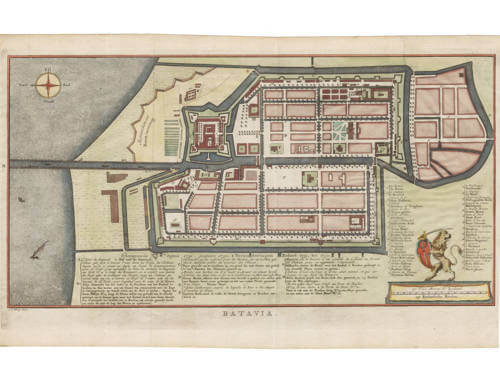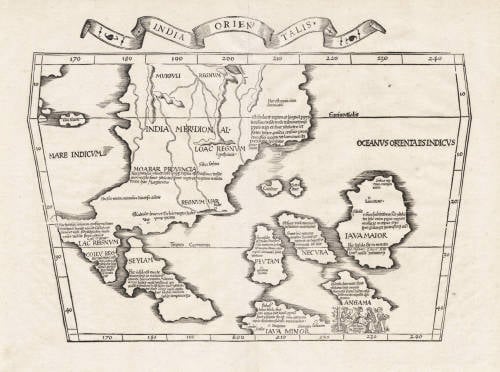Leen Helmink Antique Maps
Antique map of South East Asia by Jodocus Hondius I
Stock number: 19129
Zoom ImageCartographer(s)
Jodocus Hondius (biography)
Title
India Orientalis
First Published
Amsterdam, 1606
This Edition
1623 Latin
Size
34.0 x 48.0 cms
Technique
Condition
excellent
Price
$ 2,750.00
(Convert price to other currencies)
Description
A supreme example from the 1623 Latin edition of the atlas.
An excellent example. Wide margins, clean and thick paper, which is highly unusual for maps from this atlas. Paper with beautiful patina of the centuries. A crisp and even imprint of the copperplate. An excellent collector's example of this legendary map of the area.
Highly appealing map of China and Southeast Asia, with a large geographic range extending from Gujarat in the west to the coasts of Southern China with the Pearl River Estuary, Canton and Formosa (Taiwan) in the east. Three large lakes are situated in central Asia in the north, with extensive river systems running southwards through India, the Malay peninsula and Indochina. Northern Sumatra and Borneo are depicted in the south, with the Philippine archipelago, together with the Paracel Islands, shown as a diagrammatic shoal, to the east.
(Christie's)
Condition
A pristine example in spectacular original hand color, applied at the time of production by colouring department of the publishing house. Wide margins, clean and thick paper, which is highly unusual for maps from this atlas. Paper with beautiful patina of the centuries. A crisp and even early imprint of the copperplate, from the 1619 edition for the French markets. No restorations or imperfections. One of the best examples ever seen. A magnificent collector's example of this legendary map of the area.
Mainland Southeast Asia, Jodocus Hondius, 1606 (35.5 x 48.6 cm)
Hondius shared the classic view of Southeast Asia' river systems, mapping five rivers from the Mekong westwards, as originating in a Himalayan lake associated, if not in Hondius’ mind, with the kingdom of Lan Na in what is now northern Thailand. Note also the depiction of the Mergui Archipelago, off the Burmese portion of the Malay Peninsula, as an islan-studded sea, and the exaggerated representation of the island on which the Siamese court of Ayuthaya sat (the island at the top of the Gulf of Siam).
As a youth, Hondius showed a talent for drawing and calligraphy, and later developed a fine reputation as an engraver. He also studied mathematics, Greek,and Latin, and the Lutheran faith. The Duke of Parma offered Jodocus the opportunity to continue his studies in Rome, but he declined the offer, probably to avoid religious conflict. Ironically, the Duke of Parma subsequently captured Ghent, where Hondius was living, and many Protestants were forced to flee, Jodocus among them. He resettled in England, where he carried on as an engraver and instrument-maker, as well as a maker of maps and portraits. He returned to the Continent in 1593 and set up shop in Amsterdam. Here he was successful as a maker of large wall maps and of globes, for which he had obtained, in 1597, the privilege from the Staten Generaal. In 1604 he acquired the copperplates from the Mercator Atlas, which he began publishing two years later, supplemented by his own, more up-to-date, maps. Two of his new contributions covered Southeast Asia: this map focusing on the mainland, and one devoted to the islands."
(Thomas Suárez)
Jodocus Hondius (1563-1612)
Jodocus Hondius the Younger (son) (1594-1629)
Henricus Hondius (son) (1597-1651)
Jodocus Hondius the Elder, one of the most notable engravers of his time, is known for his work in association with many of the cartographers and publishers prominent at the end of the sixteenth and the beginning of the seventeenth century.
A native of Flanders, he grew up in Ghent, apprenticed as an instrument and globe maker and map engraver. In 1584, to escape the religious troubles sweeping the Low Countries at that time, he fled to London where he spent some years before finally settling in Amsterdam about 1593. In the London period he came into contact with the leading scientists and geographers of the day and engraved maps in The Mariner's Mirrour, the English edition of Waghenaer's Sea Atlas, as well as others with Pieter van den Keere, his brother-in-law. No doubt his temporary exile in London stood him in good stead, earning him an international reputation, for it could have been no accident that Speed chose Hondius to engrave the plates for the maps in The Theatre of the Empire of Great Britaine in the years between 1605 and 1610.
In 1604 Hondius bought the plates of Mercator's Atlas which, in spite of its excellence, had not competed successfully with the continuing demand for the Ortelius Theatrum Orbis Terrarum. To meet this competition Hondius added about 40 maps to Mercator's original number and from 1606 published enlarged editions in many languages, still under Mercator's name but with his own name as publisher. These atlases have become known as the Mercator/ Hondius series. The following year the maps were re-engraved in miniature form and issued as a pocket Atlas Minor.
After the death of Jodocus Hondius the Elder in 1612, work on the two atlases, folio and miniature, was carried on by his widow and sons, Jodocus II and Henricus, and eventually in conjunction with Jan Jansson in Amsterdam. In all, from 1606 onwards, nearly 50 editions with increasing numbers of maps with texts in the main European languages were printed.
(Moreland and Bannister)
Related Categories
Related Items






